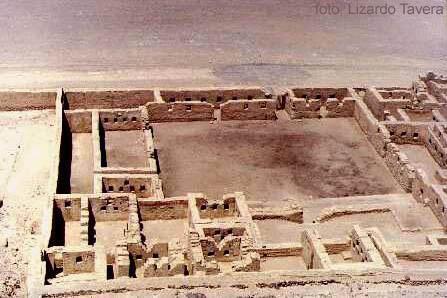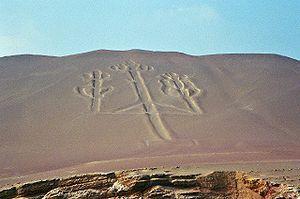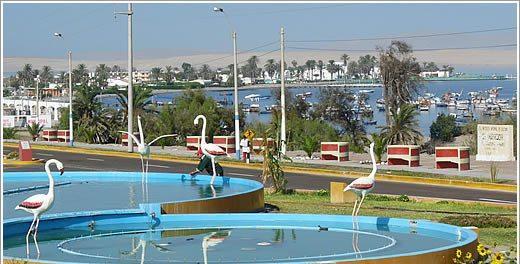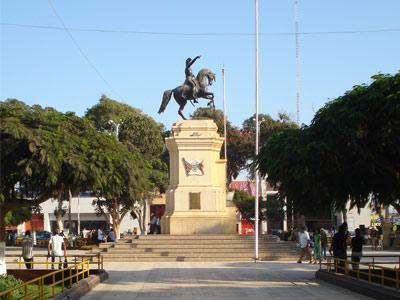Pisco, Ica, Peru
Suggest Place to Visit
2547
Track to location with GPS |
 |
Pisco is a place that was within the territory of the pre-Hispanic Paracas and Nazca cultures, even towards 1000 BC. C. the first sedentary settlement occurred due to the enormous marine wealth that the ancient inhabitants collected. In that sense, its cultural and historical vestiges are extensive.
The town of Pisco, a Quechua name that means ´´bird´´, was founded in 1640, in the vicinity of the indigenous site of the same name. It was an ancient seat related to the extraction of guano from the islands, highly appreciated as a fertilizer in pre-Hispanic Peru.
Pisco suffered a strong earthquake in 1680, along with the attack of the pirates Clerck and David. Then Viceroy Melchor Antonio Portocarrero Lazo de la Vega (1689-1705, during the reign of Carlos II of Spain, 1665-1700, from the House of Austria) moved the city to its current place and re-established it as Our Lady of Concord from Pisco. With the establishment of the viceroyalty of Peru, the port of Pisco served as a departure point for quicksilver from Huancavelica and for the pisco produced in the nearby valleys.
In 1820, José de San Martín landed on a nearby beach (Paracas) to the port of Pisco (today destroyed by the earthquake of August 15, 2007). In the city, the house where the liberator created the first flag of Peru stands out.
In 1832 it was renamed Villa de la Independencia, in honor of the Independence of Peru but when it was declared a city in 1898, it recovered its old name of Quechua origin.
Currently, both its port and its agriculture and its wine and pisco industry stand out since the first years of the colonial period. This Peruvian city appears on the first known maps of the 16th century.
On August 15, 2007, the city was shaken at 6:40 p.m. by a strong earthquake measuring 8.0 degrees on the Richter scale that left 70% of the city in ruins, in which 519 people died, there were 42 disappeared and 16,000 houses were destroyed according to figures from the INDECI (National Institute of Civil Defense). A city reconstruction project is planned to the southeast of the current site, which includes the construction of an airport and is expected to take place over the next 20 years.
Pisco is a city in south-central Peru, capital of the Province of Pisco (Department of Ica), located 290 km southeast of Lima on the shores of the Peruvian Sea, south of the mouth of the Pisco River.
The city includes both the town, known as Pisco pueblo and the port and the boardwalk, known as ´´Pisco playa´´. It currently has industrial cotton ginning activity and some other industries related to fishmeal and fish oil, textiles, chocolates, guano from the islands, etc.
Tourist destinations in Pisco
Paracas
Its proximity to the Paracas National Reserve makes the city of Pisco a starting point for expeditions to both the Reserve and its coastline, in which the Ballestas Islands stand out.
Tambo Colorado
It is possible to visit the archaeological remains of Tambo Colorado, a well-preserved Inca urban center, which are located half an hour from the city of Pisco on the road to Ayacucho or ´´Vía de Los Libertadores´´.
Ballestas Islands
The Ballestas Islands are a refuge for sea lions and various birds. The circuit to the place is done in boats, which allows to appreciate these species in their environment safely.
It was an Inca settlement (1450) located in the province of Pisco, a valley of the same name, on the right bank, in a corner formed by the hills near the town of Humay. It is one of the best preserved archaeological sites in Peru, typically Tahuantinsuyo in its outline and architectural design. It presents the singularity of being built in adobe, as an example of the adaptation of Quechua architects and engineers to the new coastal environment that they were beginning to conquer.
Tambo Colorado, also known as Pucallacta or Pucahuasi (from puca, red in Quechua); It is divided into three large sectors, north, center and south, separated by the road that goes down from the mountains to the coast and a large trapezoidal plaza, which has an Ushno, a small platform where the Inca himself directed the most important festivities of Tahuantinsuyo .
From the top of this tiny pyramid you can see very clearly much of the wide and fertile valley that stretches towards the sea. The north sector is a large building built leaning on the skirt of a hill, with a single access, with walls and right angles; It is organized around a large patio, surrounded by about 30 enclosures, measuring 100 meters wide by 150 meters deep. On both sides, smaller buildings were built. The walls are painted in red, yellow and white, decorated with niches and trapezoidal openings, as well as decorative friezes. In some places you can find evidence of huarango wood posts that supported the thatched roofs. The access openings are trapezoidal, with ´´double jamb´´, an ornament only used in buildings of great importance, such as the Coricancha and Machu Picchu.
This site was built during the wars that the Incas waged against the coastal nations, that is, in the middle of the 15th century, probably during the Pachacútec government.
Cathedral
Paracas Candelabra Rock formation caused by marine erosion. The concave shape of its structure, reminiscent of cathedral domes, gave it its name.
The candelabrum
Geoglyph. Its large dimensions and its design on the sand allow distinguishing a relationship with the lines and geoglyphs of Nazca and Pampas de Jumana. Its origin is still a mystery (one theory indicates that it was made by José de San Martín, interpreting that it is a symbol of Freemasonry and another that it is a signal for navigators).
Comments
We don´t have yet any comments about:
Pisco City
Pisco City
Be the first to leave a comment as it is very important to inform other people
Outros locais a visitar
Within a radius of 20 km from:Pisco City
Complejo Arqueologico Tambo Colorado |
| 5,1 Km |
 |
El Candelabro |
| 14,9 Km |
 |
Paracas city |
| 15,4 Km |
 |
Hotel reservation near Pisco City within a radius of 20 km
Why to book with BOOK HOTEL ALGARVE
The best prices
Our partnerships with the world´s largest operators offer research on the best market prices.
More options
At Rotas Turisticos you can book the hotel, buy the air ticket, book the transfer from the airport to the hotel and vice versa, book the local excursions, rent the car, take travel insurance and consult the places to visit and where to go.
Holiday Tips & Destinations
Hundreds of holiday destinations with all the options that allow you to easily choose the destination that best suits your dream vacation.
BOOK HOTEL ALGARVE
Links






